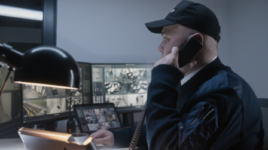Can Police Track Your Location From a Phone Call? Phone Tracking and Tracing in Australia

We’ve all seen in movies that classic scene where the criminal on-the-run makes a phone call to police, taunting them, only for officers to spring into gear and try to ‘trace the call’.
Whilst real-life phone tracking / tracing is far less dramatic than it appears on screen, obtaining location data as a result of phone intercept is a key tool utilised by law enforcement in Australia.
Here’s an outline of the rules when it comes to tracing including the circumstances in which it can be lawfully used by police.
What is phone tracking / tracing?
Phone tracking / tracing is focused on identifying a person’s location on the basis of a phone call.
Tracing a call can occur through a variety of techniques, including:
- Accessing historical location data from the phone’s telecommunications provider.
- Accessing ‘real time’ location data, by having a telecommunications provider ‘ping’ a phone in order to identify a person’s location.
- Accessing data stored by phone applications (such as GPS data on Google Maps) to provide either historical or real time location data.
- Utilising location data contained in images or other files uploaded from a mobile phone device.
The standard method of phone tracing used by police in Australia is by accessing historical or real-time data held by telecommunications providers.
The Federal Telecommunications (Interception and Access) Act 1979 (Cth) outlines how, and in what circumstances, Australian law enforcement can access telecommunication data as well as request telecommunications providers to intercept calls in order to obtain this information. These include circumstances both with and without a warrant (a court order allowing access).
Generally, phone calls can only be traced if a police investigation is related to a ‘serious offence’. Serious offences include most indictable criminal offences including murder, terrorism, theft, fraud, drug trafficking / supply and any offence that is potentially punishable by 7 years imprisonment or more.
Can police trace your phone without a warrant?
Section 30 of the Act states that police may lawfully make an emergency request for location data from a telecommunications provider if, as a result of information conveyed by a party to a phone call (‘the caller’) they have an honest belief that:
- another person (whether or not the caller) is dying, is being seriously injured or has been seriously injured; or another person (whether or not the caller) is likely to die or be seriously injured; and
- is of the opinion that tracing the location of the caller is likely to be of assistance in dealing with the emergency.
When can police trace your location from a phone call?
If a single phone call requires tracing, section 46 of the Act states that police can apply for a ‘telecommunications service warrant’ from a magistrate or judge.
The magistrate or judge must be satisfied that the warrant request is being made lawfully and in accordance with the purposes of a telecommunications service warrant and the Act. They also must have regard to:
- how much the privacy of any person or persons would be likely to be interfered with by intercepting; and
- the gravity of the conduct constituting the offence or offences being investigated; and
- would be likely to assist in connection with the investigation by the agency of the offence or offences; and
- to what extent methods of investigating the offence or offences that do not involve so intercepting communications have been used by, or are available to, the agency; and
- how much the use of such methods would be likely to assist in connection with the investigation by the agency of the offence or offences; and
- how much the use of such methods would be likely to prejudice the investigation by the agency of the offence or offences, whether because of delay or for any other reason; and
A more comprehensive warrant, called a ‘named persons warrant’ can also be applied for and obtained under section 46A of the Act.
This warrant allows for multiple intercepts of multiple devices utilised by one suspect. In making a named persons warrant, the magistrate or judge must have regard to the same considerations as a telecommunications service warrant as well as:
to what extent methods (including the use of a warrant issued under section 46) of investigating the offence or offences that do not involve the use of a warrant issued under this section in relation to the person have been used by, or are available to, the agency.
Either of the warrants of above can be in force for up to 90 days after their date of issue.
Going to court over a criminal offence?
If you are you going to court for a criminal offence, call Sydney’s best criminal defence lawyers, Sydney Criminal Lawyers, anytime on 9261 8881 to arrange a free first conference during which one of our experienced defence lawyers will assess the case, advise you of your options and the best way forward, and fight for the optimal outcome.






